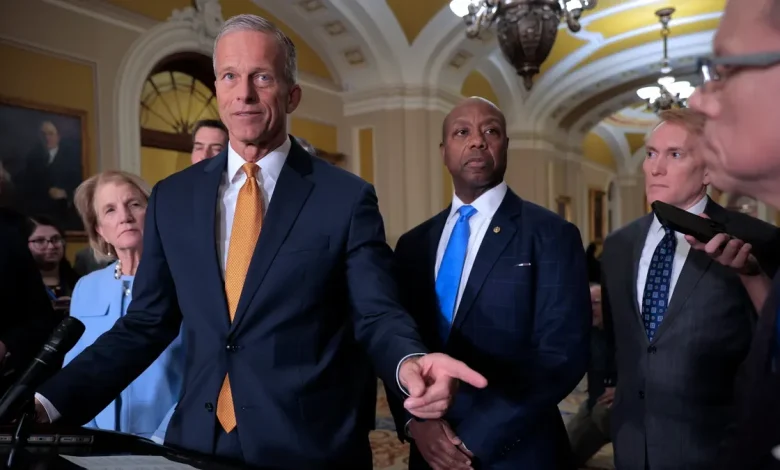Senators scramble as SNAP benefits set to expire for first time ever: Day 29 live updates

Standalone bills meant to address shutdown pain points such as expiring funding for food stamps and military pay have continued to fail.
WASHINGTON – Funding for the Supplemental Nutrition Assistance Program – commonly known as food stamps – will lapse on Nov. 1, the first time in the program’s 60-year history, as the consequences of the government shutdown spread further across the country.
That’s why lawmakers have begun proposing more standalone bills that, while not capable of fully reopening the government, would address the crisis’ biggest pain points – from an impending gap in funding for food stamps to widespread concern over military pay.
Rank-and-file lawmakers, both Republicans and Democrats, seem to increasingly acknowledge that at some point soon, something’s got to give.
“We can work out a lot of the issues we have,” said Sen. Mike Rounds, R-South Dakota. “We don’t need to have the rest of government held hostage.”
“I really don’t think the people at home right now who are about to lose their SNAP benefits, (whose) health care premiums are doubling, tripling, quadrupling … I don’t think those people are thinking about Democrats or Republicans,” said Sen. Raphael Warnock, D-Georgia. “They’re trying to figure out how to make their families whole.”
Still, lawmakers haven’t managed to pass anything to ease the shutdown pressure on Americans. Several measures from both sides of the aisle – including bills that would pay federal workers and save safety-net programs from running out of money even as the government stays shuttered – have failed or are expected to fail, at least until party leaders change their minds.
“That is just the wrong way to do this,” Senate Majority Leader John Thune, R-South Dakota, said Tuesday. “The way to approach this is just to reopen government.”
Vice President JD Vance met the same day with Senate Republicans to talk in part about the shutdown, though lawmakers said the discussion veered primarily into frustrations about President Donald Trump’s plans to import more beef from Argentina.
The president, meanwhile, is on a multi-country trip in Asia and isn’t scheduled to return until Thursday.
Wages for staffers in the House of Representatives will be delayed until the government reopens, according to an email sent to employees Wednesday.
Their October paychecks were originally scheduled to be disbursed Friday.
Lawmakers in the House haven’t taken a vote in weeks. They remain on an indefinite 48-hour return notice.
The nonpartisan Congressional Budget Office estimates the shutdown will cost the U.S. economy from $7 billion to $14 billion – depending whether the shutdown lasts another month – that will never be recovered.
CBO said in a Wednesday letter that the country’s economic activity will be lower because of the shutdown based on fewer services provided by hundreds of thousands of federal workers furloughed, lower federal spending and reduced food assistance benefits from the Supplemental Nutrition Assistance Program.
“The reduction in output stemming from the time furloughed employees did not work will not be recovered,” CBO told House Budget Chairman Jodey Arrington, R-Texas.
The range of estimates on economic losses was based on the shutdown ending Oct. 29 to Nov. 26.
Trump’s approval rating took a slight dip in a new national poll over the last week, but still remains in a months-long plateau stretching back to mid-May.
In a Reuters/Ipsos poll released Tuesday, the president had a 40% approval rating, compared to last week’s 42%. Though the three-day poll measures a 2-point drop since the previous survey, the difference is within the margin of error, maintaining the president’s steady ratings.
The survey also found 50% of Americans were frustrated with the shutdown and another 20% were angry. Some 29% said they either didn’t care or were glad about the shutdown, according to Reuters.
Regarding a main sticking point of the shutdown, 73% of Americans polled say they want the insurance subsidies to continue as Democrats maintain, despite arguments that they will increase the federal budget deficit.
– Kathryn Palmer
Yes, Social Security payments, including Supplemental Security Income and benefits for retirement, disability and survivors, continue during a government shutdown.
Because Social Security benefit programs are considered mandatory spending by law, they are not impacted by the lapse in funding appropriations. Payments are still distributed on a regular schedule during the shutdown.
Social Security offices are still open during the shutdown, but only some services are available.
Senate Democratic Leader Chuck Schumer urged colleagues to approve legislation to extend SNAP food assistance despite the government shutdown, but Republicans called it a cynical attempt to avoid blame for starving low-income families.
The Supplemental Nutrition Assistance Program has become a flashpoint in the shutdown because 42 million Americans receive SNAP benefits that will run out Nov. 1.
Schumer of New York said the government found ways to fund SNAP during all previous shutdowns, including the longest one in 2018 and 2019 during Trump’s first term. He called the argument Trump can’t provide the benefits during the funding lapse “nasty, vicious, self-serving bull.”
“Republicans are on a crusade to kill SNAP,” Schumer said on the Senate floor on Wednesday.
But Senate Majority Leader John Thune, R-South Dakota, said the legislation wouldn’t cover military troops or federal law enforcement officers or air traffic controllers who are working without paychecks. The bill also wouldn’t provide rental and housing assistance or small business loans or Head Start, he said.
“Democrats don’t want the bad press of hungry Americans,” Thune said. “This bill is a cynical attempt to buy political cover for Democrats to allow them to carry on their government shutdown even longer.”
The current shutdown is now the second longest in history at 29 days.
The longest shutdown ever lasted 35 days, from December 2018 to January 2019, during Trump’s first term.
That means that if the shutdown continues to Election Day, on Nov. 4, the record will tie. If the current impasse lasts longer, it will take the place as the longest shutdown in history.
House Speaker Mike Johnson told reporters it would be futile for his chamber to vote again on a short-term funding bill to reopen the government because most Senate Democrats would still oppose it.
The House voted Sept. 19 to extend government funding through Nov. 21. As that date approaches with no resolution to the impasse, lawmakers have begun discussing temporarily funding into early 2026, to allow time to approve legislation for full-year funding.
But Johnson, R-Louisiana, told reporters on Wednesday that bringing the House back and holding another vote would be met with the same Democratic opposition. All but three Senate Democrats voted against reopening the government until health care funding is increased.
“Wouldn’t that be a futile exercise?” Johnson asked. “It would meet the exact same fate. What would be the point of that?”
The chair of the House Foreign Affairs Committee, Rep. Brian Mast, said the shutdown revealed a difference in values between Republicans and Democrats reflected in Trump negotiating trade agreements while most Democrats refuse to reopen the government.
Mast, R-Florida, said Trump is negotiating in Asia to maintain access to rare earth minerals, which are crucial for electronics. China has restricted exports of the minerals as part of a trade war over U.S. tariffs.
“The president is abroad trying to protect our homeland,” Mast told reporters on Wednesday. “That’s a difference of values.”
Meanwhile, Mast said he spoke with embassy personnel in an unspecified country who are worried about having enough funding to evacuate during the shutdown. Workers are worried about gas for vehicles and diesel for generators, he said.
“Those are the real-world consequences,” Mast said.
More than 42 million people across more than 22 million households relied on SNAP benefits every month during fiscal year 2025, according to the USDA.
In total, that means around 12% of the more than 342 million people in the United States utilize the benefits.
According to the USDA’s fiscal year 2023 report on the SNAP program, its latest annual data, the largest age bracket of those who relied on the benefits were adults ages 18 to 59.
However, children accounted for about 39% of the people who received the benefits, according to the data.
In fiscal year 2025, the average monthly benefit per person in the SNAP program was $190.59, per USDA. For households, the average monthly benefit was $356.41 in total.
– Melina Khan
Agriculture Secretary Brooke Rollins said her department lacks the $9.2 billion to pay for SNAP benefits in November after a coalition of 25 Democratic-led states sued the Trump administration over plans to end the food-stamp program beginning Nov. 1 amid the government shutdown.
“We don’t even have close to that in contingency funding,” Rollins said in a Tuesday afternoon interview on CNN. “We’ve got to get this government open.”
Plaintiffs in the lawsuit argue the USDA is obligated to use funds from its $6 billion in contingency funds to cover SNAP in November, but Rollins has said the emergency money can’t be used for this purpose. The position seems to contradict previous USDA guidance that said the money was available “in the event that a lapse occurs in the middle of the fiscal year.”
Rollins downplayed the guidance, dated Sept. 30, as an “iterative document.” She also said the emergency fund isn’t large enough to cover the shortfall. During the shutdown, Rollins said the department has spent money to open Farm Service Agency offices and pay food and safety inspectors, while also maintaining the SNAP program in October.
“The SNAP program in November costs $9.2 billion,” Rollins said. “We don’t have the legal authority, as of today, to distribute anything less than that through the formulas, etcetera. We’re obviously looking at all of this as we move forward.”
A federal judge on Tuesday further blocked Trump’s administration from following through on plans to lay off thousands of federal employees amid a nearly month-long partial government shutdown.
During a hearing in San Francisco, U.S. District Judge Susan Illston extended an earlier temporary ruling barring nearly 40 federal agencies from implementing layoffs pending the outcome of a legal challenge by unions that represent federal workers.
About 4,100 employees at eight agencies had been notified that they were being laid off before Illston’s Oct. 16 ruling, the Trump administration said in court filings. White House Budget Director Russell Vought has said that more than 10,000 federal workers could lose their jobs because of the shutdown.
– Reuters
Vice President JD Vance told reporters at the Capitol on Tuesday that military members will receive their next paychecks despite the ongoing government shutdown.
“Will the troops get paid on Friday? Yes,” Vance said, according to reports. “We believe that we can continue to pay the troops on Friday.”
However, the vice president did not provide additional details on what funds the government will use to pay military members. Troops, like millions of federal workers, see their paychecks on the line when the government shuts down.
– Marina Pitofsky





